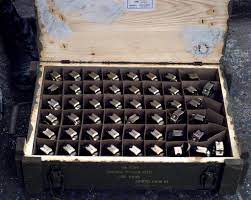
Diehl Defense, a prominent player in the defense manufacturing sector, has recently initiated the production of 300,000 defensive-offensive hand grenades. The substantial procurement has been commissioned by the Bundeswehr, the German army. According to intelligence from the German source Hart Punkt, a significant portion of the order, estimated at 100,000 units, is expected to be comprised of the “Explosive/Splitter, DM51A3 with DM82A4 hand grenade fuse” variant.
An official report released by the BAAINBw on January 3, accessible on the European online procurement platform TED, discloses that the contractual agreement was finalized on December 28 without undergoing a competitive bidding process.
The absence of a bidding invitation for this procurement in Germany can be attributed to Diehl Defense’s exclusive proprietary rights over the DM51 grenades, as highlighted by Hart Punkt. Originating in the 1970s and crafted by Diehl Defense, the DM51 stands as a versatile offensive/defensive hand grenade of German origin. The company’s objective was to streamline the German army’s grenade arsenal by replacing various types with a singular model, resulting in the development of the DM51. With the capability to toggle between offensive and defensive roles through the addition or removal of a fragmentation jacket, this versatile grenade offers adaptability on the battlefield.
Structurally, the DM51 comprises a high-explosive grenade body featuring a detachable jacket facilitating fragmentation. The defensive configuration can be easily converted into an offensive one by rotating the jacket 90 degrees. The cylindrical grenade body incorporates a top-mounted fuse activated by pulling a pin. Reinforced with robust ribs, the outer jacket serves both as a strengthening component and a reliable gripping surface. Additionally, DM51 grenades can be interconnected to amplify their impact or construct a consolidated Bangalore torpedo.
The grenade’s explosive core is loaded with 60g of Nitropenta, providing a lethal blast radius within a few meters. Upon attachment of the fragmentation jacket, the lethality and effective range of the grenade are significantly heightened. The DM51 has been standardized as the primary grenade across all branches of the German military.
While the precise financial details of the hand grenades encompassed in this procurement remain undisclosed, it has been officially communicated that the fulfillment of the order is slated for completion by the conclusion of April 2025.
To provide a rough estimate of the financial magnitude, the pricing information for a DM51 hand grenade in 1996, set at 33.60 euros, serves as a reference point. Adjusting for inflation, the current valuation of a single grenade is approximately €52.66. Consequently, the potential total value of this procurement is estimated to be around €5.26 million.
Analysts posit that the specific request for 100,000 hand grenades may be linked to recent geopolitical developments in Ukraine. In 2022, Germany supplied Ukraine with DM51A2 hand grenades from the Bundeswehr’s reserves. The reconstitution of the Bundeswehr’s diminished stock of the “donated” hand grenades has been entrusted to Diehl Defense.
The operational mechanism of the DM51 relies on a timed fuse. Upon removal of the safety pin and release of the safety lever, the fuse is activated. This initiation sets off a delay element, typically composed of a slow-burning material, which undergoes controlled combustion for a predetermined duration before initiating detonation.
Upon the completion of the burning process in the fuse’s delay element, the detonator is triggered, subsequently igniting the primary explosive charge. The resulting explosion generates a shock wave that fractures the casing, transforming it into a dispersal of lethal fragments that radiate outward in all directions.




